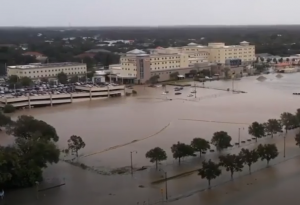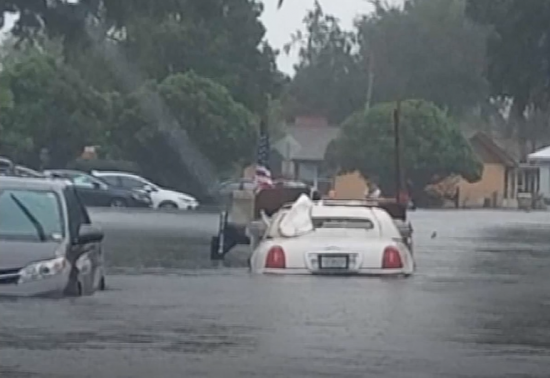Many feared uninsured

Flooding in Kissimmee as Hurricane Ian passes through, September 29, 2022.
Governor DeSantis this past week said again that Hurricane Ian was both a wind and a flood event. “I’ve toured up and down the state and I would say the flood far exceeds the wind damage in terms of what I’m seeing,” he said from the Ft. Myers insurance village. That includes damage he saw in Central Florida, too. State meteorologists said this was a 1 in 500 year flood event in some locations of the state. In his public briefings, the Governor clarified the difference and coverage between a wind and a flood damage claim, telling residents their flood claims wouldn’t likely be covered under their homeowners insurance policies, as you can watch in this video clip. The Governor acknowledged that many residents didn’t live in a so-called “flood zone” and were likely told they didn’t need a flood policy, and could sympathize with why they didn’t purchase one as a result. As those of us in the insurance business know, if it can rain, it can flood – and it did with Ian big-time.
While those who had mortgages and lived in a flood zone were required to have flood insurance, many of the rest of the residents likely didn’t. Only 15% of Florida properties have federal flood insurance (compared to 4% nationwide) even though most catastrophes involve flooding. The Miami Herald’s interactive map shows federal flood insurance penetration by county and by those living in Special Flood Hazard Areas (SFHA) requiring flood insurance with mortgages. In Lee County, where Ian came ashore, only 30.7% of residential structures had National Flood Insurance Program (NFIP) policies and only 51.4% of those living in SFHAs. A sample of other badly impacted counties shows these percentages with federal flood policies:
- Charlotte, 32.9% of homes, 50.9% of homes in SFHAs;
- Collier, 48.2% of homes, 60% of homes in SFHAs;
- DeSoto, 3.3% of homes, 26.6% of homes in SFHAs;
- Hardee, 1.3% of homes, 16.4% of homes in SFHAs;
- Osceola, 6.1% of homes, 31.1% of homes in SFHAs;
- Orange, 3% of homes, 31.5% of homes in SFHAs;
- Polk, 2.5% of homes, 25.5% of homes in SFHAs;
- Sarasota, 19.3% of homes, 51.1% of homes in SFHAs;
- Seminole, 3.9% of homes, 37.6% of homes in SFHAs; and
- Volusia, 10.7% of homes, 44.6% of homes in SFHAs.

Floodwaters swamp vehicles in Daytona Beach during Hurricane Ian, September 30, 2022
While Florida’s private flood insurance companies have made great inroads, we fear that many with flood damage from Ian will be uninsured. FEMA individual assistance grants don’t replace insurance and the amount is capped both for repair and for personal belongings (at about $38,000 each but the average grant is much less than that amount). NFIP policies limit structural damages to $250,000 for a home and $500,000 for a business and limit contents coverage to $100,000 for a home and $500,000 for a business. They do not cover homeowners’ living expenses, such as temporary housing, nor cover loss of income suffered by businesses due to a flood. (See our 10 Facts About the National Flood Insurance Program.) Politico picked up on this in their piece Ian inflicts staggering losses on Florida’s growth machine and showed how the median home price in some of these counties is well above the $250K NFIP policy limit.
So what do we do? State senator Jeff Brandes is calling for a special session of the Florida Legislature right after the November 8 election to deal with some of the core issues impacting the property insurance market, including tort reform. “We were in crisis three years ago. But we are in wholesale collapse at this point,” Brandes told NPR, adding “You’re going to price the middle class out of residential homeownership,” from the resulting insurance rate hikes. The Governor last Tuesday said “I will call another special session but I think it’s premature to know kind of exactly…the combination of wind and flood damage….I would say the flood far exceeds the wind damage.” Paul Handerhan of the Federal Association for Insurance Reform said “expanded public reinsurance capacity is a must,” for the legislature to consider. You know we’ll be following developments and report back to you in this newsletter.
One last note on wind vs. water and the power of tougher building codes. We heard remarks from several contractors last week that homes built under the 2007 building code came out of the storm just fine overall. The Governor, too, took note. “You don’t see as many roofs blown off of a house that was built 10 to 15 years ago than you do the ones built in like the ‘50s or ‘60s.”
LMA Newsletter of 10-10-22

